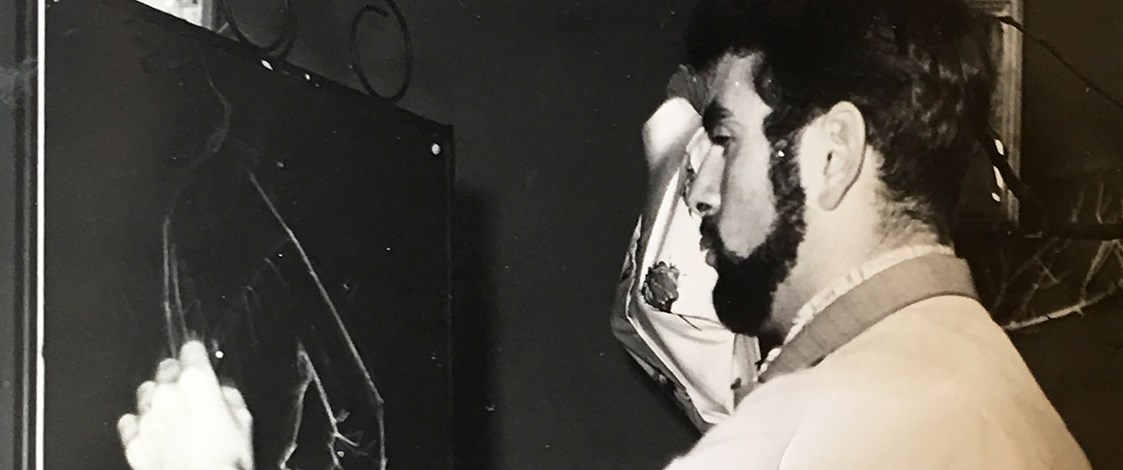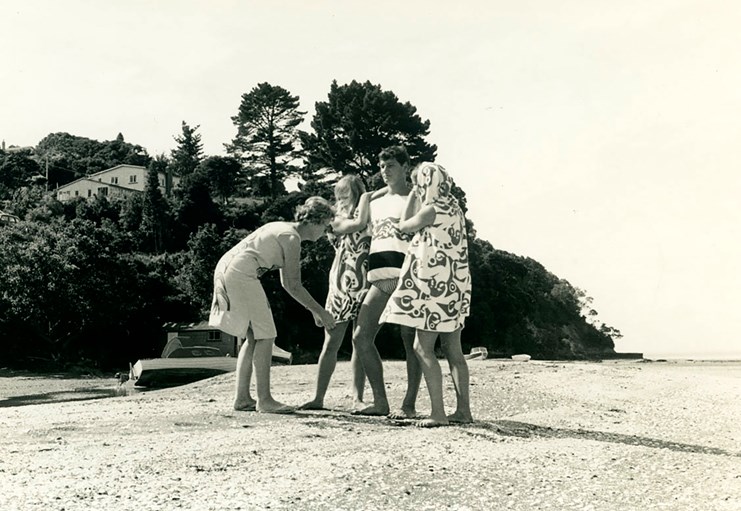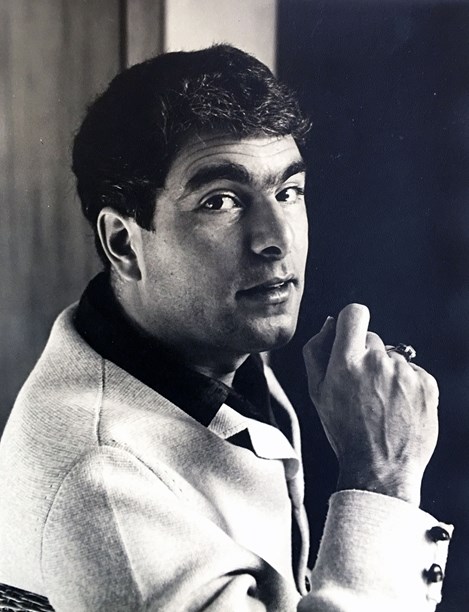Stories
Robert Leek
1935-2019

Robert Leek only worked in the New Zealand fashion industry for a little more than a decade, but the European-trained designer was to make a big impact on men’s fashion in the 1950s.
Born in the Netherlands in 1935, Robert studied fashion at the Stads Academie in Maastricht, a comprehensive four-year course that included pattern making, fashion illustration and design. Class assignments included creating collections as well as designing and printing the invitations and catalogues for the fashion show.
In the post war years the Netherlands was facing economic hardship and emigration to New Zealand, Australia and Canada was an attractive option especially for the young and adventurous. While Robert was still at grammar school, his brother Gouke and his sister Else settled in New Zealand and his parents were making plans to follow them. In 1957 Robert was enrolled in a summer course in tailoring at the Rotterdamse Snijschool (Rotterdam tailoring academy) and he wasn’t that keen to leave. "Life in the Netherlands had improved since the early 1950s. My years in art school were enormous fun and there were plenty of opportunities for a career," Robert recalled.
Fashion illustration from Robert's tailoring course portfolio, 1957. Image © Robert Leek.
Still, Robert did come to New Zealand in December 1957. Not long after he arrived, his sister and brother in law, Else and Walter van den Muysenbergh, took him to fashion designer Rosemarie Muller’s annual Christmas party. "I immediately felt at home," he recalled. "There was a great community of creative Dutch immigrants living in Titirangi." These included the Dutch fashion photographer Ted Mahieu, furniture designer Pieter Smeele, potter Simon Engelhardt and the screenprinter Frank Carpay and his wife Carla.
Carla Carpay and Robert’s mother both worked for Rosemarie Muller, who had established her Titirangi workroom a few years earlier. Carla worked as a machinist for a brief time and Robert’s mother worked as a hand-finisher. Robert’s sister Else van den Muysenbergh modelled for Rosemarie and for many of the top designers of the time Babs Radon, Colin Cole, Emma Knuckey and for Bruce Papas in the Milne & Choyce shows.
Initially Robert didn’t intend to work in fashion and took a portfolio of his graphic design work to a number of advertising agencies. He discovered that the agencies trained their own designers in-house rather than employing art school graduates. So it was that he found himself in full-time employment in New Zealand in fashion at Suzy Gowns in Morningside.
With his European fashion sensibility and a well developed sense of personal style Robert was unimpressed by the men’s clothing on offer in New Zealand. When the chance to design menswear came up he was keen to take up the challenge. In between modelling jobs, Else was a "very glamorous" salesperson at the Shirt Centre in Auckland’s Queens Arcade. Her employer, Owen Church, had taken an interest in Robert’s fashion illustrations and introduced him to an Austrian emigre manufacturer who was looking for a European designer. The only drawback was that the business was in Levin, far from his family and the Auckland Dutch community.
Robert agreed to work for Kurt Hager for two and a half years and moved south in August 1958. The business was reasonably new and the owner, Kurt Hager, wanted to manufacturer European influenced and fashion led menswear. Shirts and jackets were to be manufactured in the latest fabrics and detailed with variations in the cut and shape of collars, lapels and body fits. The Hager range was sold in retail stores throughout New Zealand. New styles were promoted at events such as the Easter Show in Auckland and the Winter Show in Wellington. Often Robert took to the catwalk to model his own designs.
When Robert returned to Auckland in 1960 he left behind a well trained design staff that included an apprentice, Perrin McLeod, who would go on to forge his own independent design path.
It didn’t take Robert long to find an outlet for his design talents on his return to Auckland. E L Riley Ltd produced industrial clothing, including more than 7000 pairs of Tufguy jeans a week. Based on May Road in Mt Roskill and owned by cousins Lionel and Harry Melzer, the company was in the unique position of holding a large number of fabric import licences in recognition of their work manufacturing uniforms during the war. They were looking to exploit some of these and take on the fashion market. Robert’s role was to bring his European eye and fashion flare to design for the Riley label. By the end of his time there he had a staff of six in the design workroom. "All I did was select fabrics and look after the technicalities of working with new fabrics. It was a very broad range."
The range included men’s and boys sportswear, ladieswear and rainwear and his garments proved to be very popular. "Lionel’s wife reckoned that my slacks were the best fitting slacks that she ever had. I had a special way of moulding the front of slacks and they sat much better on the body."
Robert’s designs for Riley, were manufactured alongside other labels that they made under licence - Casbah, Lincoat, Tomboy, Tufguy, Racer and Surfrider.
While he was working at Riley’s, Robert also designed garments for his friends and fellow Dutch emigres, Frank and Carla Carpay. Frank worked as a designer at Crown Lynn and a high school art teacher before he and Carla started a textile design business in the basement of their Titirangi house, Frank Carpay Designs Limited. They started by screen printing beach towels with simple motifs, but soon realised their designs would work well as beach wear. Robert began designing towelling garments including beach jackets and shift dresses.
With the Youthquake audience in mind, Frank and Carla’s photos of their 'Carpay beach wear' portray a sophisticated European style. Robert and Else were called on to model, and Ted Mahieu’s photographs depict a glamorous lifestyle, lounging on deckchairs or frolicking on the beach.

Robert Leek models a Carpay garment, 1960s. Photo by Ted Mahieu.
By the mid-1960s, Carpay beach wear was appearing in the Woman’s Weekly and the New Zealand Herald. Frank and Robert also branched out from towelling and designed a range of simple linen shift dresses. But a faulty shipment of towelling proved to be financially devastating for the Carpays. They were forced to close their small business and find work elsewhere.

Robert Leek, 1965. Image © Robert Leek.
Robert left Riley’s and the fashion industry in 1969. Encouraged by his friends to "do something with your brain", he had started studying English literature part time at the University of Auckland, completing a BA, an MA and then a PhD by 1972. Robert was tenured at Auckland University in 1973, where he taught Old and Middle English, Shakespeare, sociolinguistics and modern drama.
He continued to bring his design talent to bear on set and costume design for the university’s summer Shakespeare productions such as Midsummer’s Night Dream, Romeo and Juliet and Othello in which he also took the lead role. Since his retirement in 2001, Robert has taken up painting and joined the Auckland Drawing Group. Their most recent show, 'Square' was at the Pah Homestead in November 2016.
Text by Kelly Dix. Banner image of Robert Leek sketching at Hager, 1960. Image © Robert Leek.
Last published October 2017.